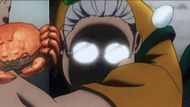Few protagonists in modern manga are as deceptively unassuming as Taro Sakamoto in Sakamoto Days. At first glance, he’s a chubby, laid-back family man who spends more time behind the cash register than in the field. But beneath the apron and glasses lies one of the most dangerous assassins ever to live, a man once hailed as the strongest member of the Order, the elite group of killers at the top of the underworld food chain.
To understand his true strength, we need to break down his history, skills, physical attributes, and how he stacks up against the deadliest assassins in the Sakamoto Days universe. From his student days at the JCC (Japanese Assassin Academy), Sakamoto was recognized as a once-in-a-generation prodigy.
Byodo, the JCC’s “database” of talent, openly admitted that out of 38,000 students he had evaluated, Sakamoto was the single greatest fighter he had ever seen. Alongside Nagumo and Rion Akao, Sakamoto was considered part of the “big three” of his generation, but even among them, he consistently outshone his peers.

In Sakamoto Days, his rise through the underworld was meteoric, culminating in his induction into the Order, where he quickly earned the reputation of being its strongest member.
This title in Sakamoto Days wasn’t just hype. Sakamoto could singlehandedly wipe out entire branches of the JAA (Japan Assassin Association). His mission record was flawless, with no target escaping him, except for one, Kei Uzuki, the man who would later become the series’ main antagonist.
Physical power of Taro in Sakamoto Days

Sakamoto’s strength is legendary in Sakamoto Days. Even in his “weakened” form, his feats are beyond human:
- Stopping a speeding bus with nothing but a street sign.
- Stabilizing the collapsing Tokyo Tower by yanking on steel cables.
- Destroying deadly chakrams with a frying pan.
- Serve restraints with a coupon sheet.
- Overpowering mechanized dinosaur skeletons in hand-to-hand combat.
He can casually throw his wife over a suspension bridge or swat opponents through multiple walls. His fight with Kanaguri, a former Order member, proves that even at 30%, Sakamoto is still operating at a level most assassins can’t hope to match.
When he shifts into his “skinny” form, a sudden transformation that burns off fat and returns him closer to his prime physique, his strength skyrockets. Against Boiled, an assassin who nearly overwhelmed him, Sakamoto shredded him with terrifying ease once he slimmed down.
Speed and reflexes: Faster than bullets

If strength defines his presence, speed defines his legend. Sakamoto in Sakamoto Days has demonstrated reflexes and agility so refined they border on supernatural:
- Dodging coordinated attacks from elite assassins Son-Hee and Bacho.
- Running through an entire moving train in seconds.
- Catching up to a speeding bus on foot.
- Swatting aside sniper rounds mid-flight, even from Heisuke.
- Blocking a bullet fired point-blank at his head using only a fork.
His reflexes go beyond combat utility; they’re comedic in execution but terrifying in implication. He can scoop boiling water out of the air with a ramen cup or swipe a card during Old Maid without anyone noticing. In terms of reaction time, very few in the series compare.
Durability and endurance: A living fortress

Strength and speed mean little without durability, and Sakamoto is nearly unbreakable. He’s tanked explosions strong enough to demolish buildings, falls from lethal heights, and direct strikes from other Order-level assassins. His fat even functions as natural armor, letting him endure razor-wire sharp enough to slice steel beams.
Remarkably, Sakamoto in Sakamoto Days never shows fatigue. From drawn-out brawls to high-intensity infiltration missions, his stamina is seemingly limitless, reinforcing why his opponents often crumble before he does.
Battle IQ and improvisation

Sakamoto’s most underrated weapon is his mind. He isn’t just strong; he’s endlessly adaptable. Known for turning anything within reach into a lethal tool, he has weaponized:
- Popsicle sticks
- Chopsticks
- Vacuum cleaners
- Frying pans
- Traffic signs
- Cough drops
This resourcefulness in Sakamoto Days makes him unpredictable. Where other assassins are limited by their weapon of choice, Sakamoto can transform an ordinary setting into a battlefield stacked in his favor. As Rion once pointed out, if she fought him with only a knife in an empty room, she might win. But in any environment filled with random objects, Sakamoto becomes unstoppable.
Final thoughts
In his prime, Sakamoto was the strongest hitman of all time, an apex predator who defined what it meant to be part of the Order. In his current state, he is still among the most powerful characters in the Sakamoto Days, capable of defeating Order-level threats without relying on his lethal edge.
Whether behind a counter or on the battlefield, Sakamoto isn’t just a hitman; he’s a natural disaster in human form, proof that legends never fade, they simply change shape.
